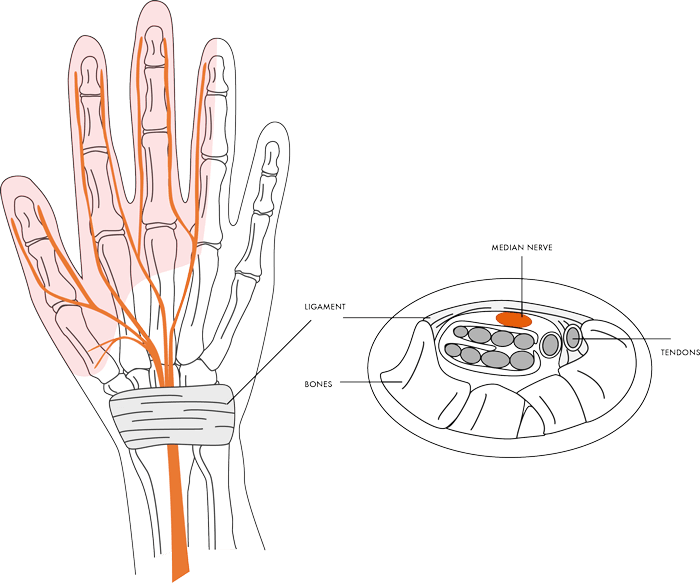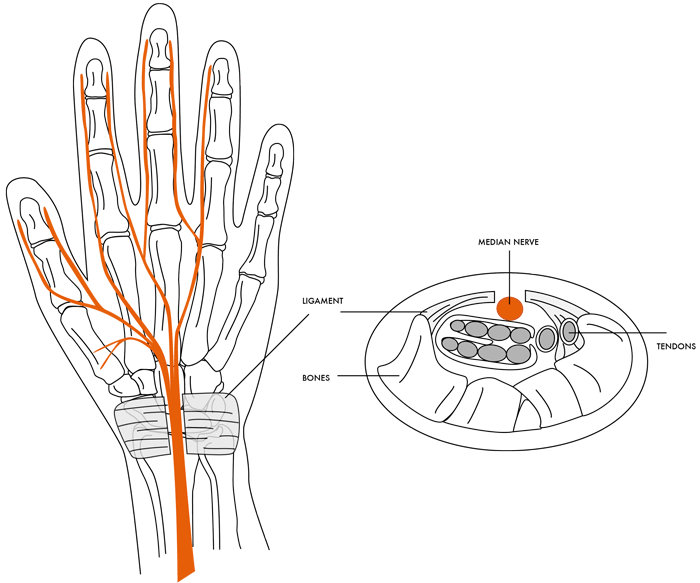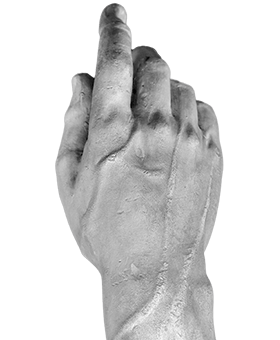Overview
The carpal tunnel is an anatomical space at the base of the hand through which a number of structures pass. Of greatest importance to those with carpal tunnel syndrome is the median nerve. As one of the major nerves supplying power and sensation to the hand, compression or damage to the median nerve can cause significant impairment.
A thick, fibrous band of tissue called the flexor retinaculum spans the carpal bones in the hand to form the carpal tunnel. As such, the tunnel is a strong, fixed space allowing passage to the tendons and nerve. For a number of reasons, the pressure in this tunnel can increase and, because it is a relatively soft structure, the nerve is compressed.
Symptoms
Patients will report pins and needles in the median nerve distribution of the affected hand – the thumb, index , middle and ring fingers, but not the little finger. This sensation can extend into the palm and sometimes even radiates up the arm. The numb feeling is exacerbated when the wrist is flexed forward for extended periods, such as holding the steering wheel or holding a book/iPad. Patients can also report waking at night due to their sleeping positions, needing to “shake out” their hands to provide relief.
Sometimes patients report difficulty picking up small things with their thumb and index finger, due to loss of sensation. In times of prolonged symptoms, there can also be a loss of grip strength due to weakness and muscle wastage in the affected nerve distribution.
Diagnosis
Diagnosis can usually be made from the symptoms, but your GP may order nerve conduction studies to confirm the diagnosis prior to your appointment. Other scans like ultrasound or MRI are not usually necessary or useful.
Dr Mackay will take a careful history and examine your hands and this is usually enough to make the diagnosis.
Treatment
Non-surgical management of carpal tunnel syndrome is sometimes possible with rest and splinting.
Surgery for carpal tunnel syndrome essentially aims to cut the transverse ligament (flexor retinaculum), across the carpal bones. This releases pressure on the median nerve, thereby relieving the symptoms. There are two options for surgery:
- Open Carpal Tunnel Release – a ~2-3cm incision is made at the base of the palm to allow surgical access
- Endoscopic Carpal Tunnel Release – an endoscope is a small camera and is used to perform the surgery via “keyhole” access. Keyhole surgery allows for small wounds and a faster recovery.


What to Expect in Recovery
Recovery rates for surgical intervention for carpal tunnel release obviously vary, depending on whether you have had an open or endoscopic release. Generally, those patients who have endoscopic surgery heal 2-3 weeks faster and have less pain because the surgical incisions are smaller. Dr Mackay will educate and advise you about the most suitable option for you. It should be noted however, that most patients experience relief from their symptoms within the first week of surgery. Most notably, patients enjoy being able to sleep through the night.
Hand therapy may not be required but can be beneficial to many patients. You can elect to see a therapist post-operatively or Dr Mackay may recommend formal therapy if your recovery is slow or complicated.
